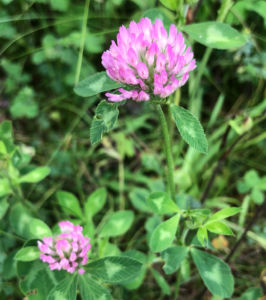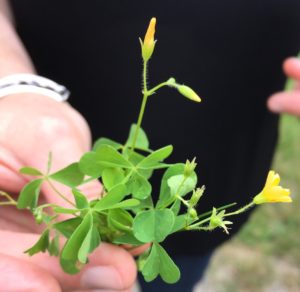A Wild and Feral Edibles Walk-About in July
By Arianna Alexsandra Collins
July is a perfect time to gather flowers and greens for salad and pesto. There is an abundance of wild and garden edibles, so why make the trip to the grocery store for produce when you have a variety of food to choose from right in your yard? The food you grow and forage on your land is free, and you can ensure ethical harvesting to sustain what flora you find and encourage.
I conduct wild edibles land inventories, and there are several flora and mushroom species that I tend to find, whether the inventory is at an urban, suburban, or rural site. Lawns and gardens tend to grow the same herbaceous plants whether you live in an urban or a rural environment. Such July edibles include wood sorrel, sheep sorrel, lamb’s quarter, viola, daylily, red clover, white clover, bee balm, milkweed, and purslane.
The names of these plants may sound familiar. A few may have volunteered themselves to take up space in your garden from seeds blown in by the wind. You may be purposefully growing some in your yard but did not know you could eat them. Or you thought they were “just weeds” and had not considered their merits of edibility.
Let’s Go Over a Few
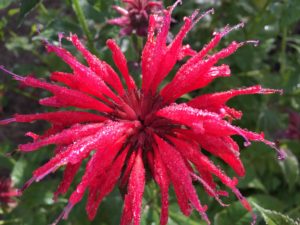
Bee Balm (Monarda didyma)
Bee balm, (red) Monarda didyma, and (pink/purple) fistulosa in the Lamiaceae family, is also known as wild bergamot. This perennial herb is native to the Northeast. As a member of the mint family, bee balm has a hard square stem that is grooved. Flowers have large “shaggy” heads comprised of about 20-50 flowers at the top of the branching stem. My mom always called them “punkies” because she thought the flowers looked like Billy Idol’s punk-rock hair. As much as I remember liking Billy Idol when I was 16, it took me a few minutes as she described this flower to me before I had the “aha” moment and realized
which flower she was referring to. Bee balm flowers have a slightly spicy taste and will zest up a salad. This flower can be used fresh or dried as a tea. Bee balm tea is antimicrobial and antispasmodic and has a soothing effect on the digestive system.
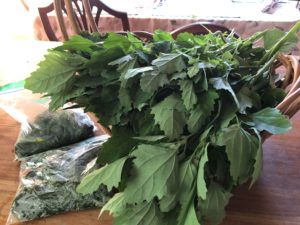
Lamb’s quarter, Chenopodium album, ready to blanch and add to soups.
In the Amaranthaceae family, Lamb’s quarter, Chenopodium album is an annual herb growing 3-5 feet tall with green, grooved, red-tinted stems. Leaves are shaped like toothy diamonds with a white glaucous (powdery) coating on the underside. All aerial parts are edible, including the tiny flower heads and seeds. This green blanches well, so you can bag it and put it into the freezer for later use in soups. Lamb’s quarters are healthy greens, rich in beta-carotene, iron, calcium, potassium, amino acids. This nutritive plant also contains phosphorus, copper, manganese, magnesium, and vitamins A, C, K, and B. Like other dark greens, lamb’s quarter does contain oxalic acid, which is removed when cooked. Unlike our domestic greens, this wild flora does not wilt in the heat of summer. Which means you can grow and harvest leaves throughout the season. Though the Chenopodium album is not native to North America, wild edibles expert Samuel Thayer clarifies that there is archeological documentation that varieties of Chenopodium have been here – and have been eaten – for thousands of years. So, welcome this resilient variety to your table!
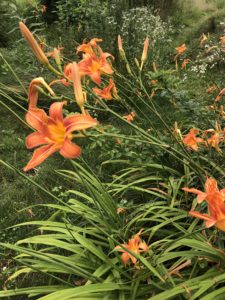
Orange daylily, Hemerocallis fulva, ready to add excitement to summer salads.
Orange daylily, Hemerocallis fulva, is a non-native member of the Hemerocallidaceae family (formally of the Liliaceae family) and has orange flowers in terminal clusters. Each flower is somewhat funnel-shaped with three recurved petals and three matching sepals. When harvesting daylily flowers, be sure you have a daylily and not a tiger lily. Toxic tiger lilies have leaves that grow up the length of the stem, while daylily leaves are grass-like and are all at the base of the stem. Additionally, tiger lilies have little black balls (bulblets) located in the upper leaf axils. Daylilies are rich in Vitamin A. They are also crunchy. If you like iceberg lettuce, you will probably be a fan of daylilies. Plus, you can arrange them to look like little flames coming out of your salad or dip – a fun visual for potlucks. If you have other varieties of daylilies growing in your garden, you can eat them as well. Again, just be sure you are observing a smooth, naked stem with all the long, tapered leaves at the base of the plant for proper identification of a daylily.
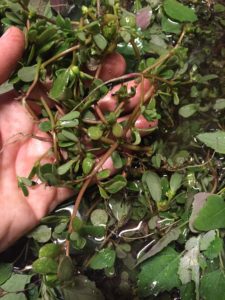
Purslane, Portulaca oleracea, suitable for making a nutritious pesto!
Purslane, Portulaca oleracea in the Portulacaceae family, sports thick, sprawling reddish stems and succulent, green leaves. Rich in omega-3 fatty acids, leaves and stems can be eaten raw or cooked. A nutritious green to use in pesto. This succulent should not be confused with hairy-stemmed spurge, which is poisonous and can be distinguished by its hairy stems and milky sap oozing from broken stems. If you are not sure if you found purslane – break the stem. Though this plant may herald from “away,” it made its way to North America long ago – pre-Columbian era – and is considered naturalized to the U.S. and much of the world.
Red Clover, Trifolium pratense, in the Fabaceae family, has round, dense flower heads that really look more purple than red. Notice a pale chevron on the upper surface of ovate leaflets. It is best to pick the flower head apart and scatter the petals into the salad instead of munching down on the whole head. No one seems to mind that this plant is not native as both red and white clovers are used as cover crops on fields. And red clover flowers are a power pack of nutrients; containing vitamins A, B1, B2, B3, and C, as well as calcium, chromium, magnesium, manganese, phosphorus, potassium, selenium, zinc, and dietary fiber.
- Red Clover, Trifolium pratense, gives bunnies something to eat other than your garden and is nutritious for humans too.
- Yellow Wood Sorrel, Oxalis stricta, is great to sprinkle on summer salads.
In the Oxalidaceae family, Yellow Wood Sorrel, Oxalis stricta, is a common non-native wood sorrel variety occurring throughout New England. It has dainty heart-shaped leaves. The flowers have five rounded yellow petals. All aerial parts are edible raw. The sour taste is from their high oxalic acid content, which is naturally occurring in several vegetables, including spinach, purslane, and rhubarb. Though oxalic acid can interfere with calcium absorption if you eat large quantities of raw plants containing it, sprinkling some leaves, buds, and flowers on salads should not be an issue.
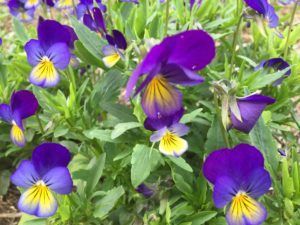
Viola, Viola tricolor, can be candied to add a floral decoration to cakes and sweets.
Viola, Viola tricolor, introduced to the U.S. from Europe, is a daintier relative of the pansy in the Violaceae family. The irregular five-petaled flowers can be purple, blue, yellow and/or white. Violas contain vitamins C and E, magnesium and calcium. They also look pretty in a salad! You can also candy them and use these sugary treats to decorate cakes and ice cream.
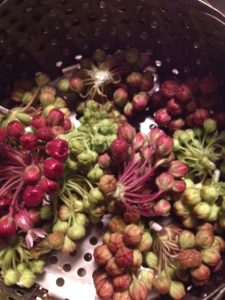
Milkweed, Asclepias syriaca, flower buds taste similar to an artichoke.
Milkweed, Asclepias syriaca, in the Asclepiadaceae family, is a North American native. This plant has a thick, green shoot covered in very short, soft hairs with opposite, elliptical leaves that are soft and hairy on the underside. The purple-green flowers grow in clusters. When any aerial part is broken, it exudes a white, milky latex substance containing toxic cardiac glycosides. Given that information, one would think milkweed inedible. But after steaming or boiling, the cardiac glycosides are rendered inert, and milkweed is safe to eat, possessing a pleasant taste reminiscent of artichoke. Gather the flower buds and flowers and steam or boil for 6-10 minutes. After cooking, you can eat plain or with butter. You can also cool and then throw buds and flowers into a food processor with oil and garlic to turn the concoction into a veggie dip. Quite tasty!
Happy foraging and enjoy the bounty of the season!
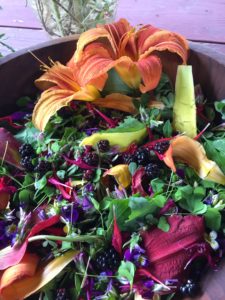
Colorful flower power July salad.
Flower Power Salad
3-4 cups greens gathered from your garden and lawn: arugula, domestic lettuce varieties, purslane, lamb’s quarter
2 cups of flowers: bee balm, day lily, red clover, white clover, yellow wood sorrel, viola
Rinse greens, dry, shred, and place in a bowl. Toss in viola flowers whole. Separate petals of bee balm and day lily and add to salad. Chop clovers and sorrel and add—Toss salad. Sprinkle your favorite vinaigrette or berry shrub and mix in. 3-4 servings. Bon appétit.
About the Author
Arianna Alexsandra Collins is a naturalist educator, writer, and wild edibles enthusiast living in Ashfield, MA. To read more of her work, visit her blog at Hearkentoavalon.com. To learn more about her wild edible land inventories, go to Offeringsforcommunitybuilding.com/wild-edibles.
***
Each author appearing herein retains original copyright. Right to reproduce or disseminate all material herein, including to Columbia University Library’s CAUSEWAY Project, is otherwise reserved by ELA. Please contact ELA for permission to reprint.
Mention of products is not intended to constitute endorsement. Opinions expressed in this newsletter article do not necessarily represent those of ELA’s directors, staff, or members.

